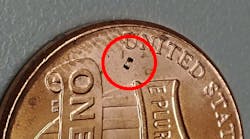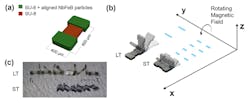Engineers at Purdue University have developed a microbot that measures about 400 × 800 microns, smaller than the head of a pin. A continuously rotating magnetic field generated inside the bot makes it tumble end-over-end to travel straight ahead or sideways.
The flat, roughly dumbbell-shaped robot, dubbed µTUM (or microTUM, for microscale magnetic tumbling robot), is made mostly of a polymer but with two magnetic ends. The midsection, which is also non-magnetic, might be modified to carry drugs or other medications. Researchers believe the robot’s small size and its ability to move autonomously through wet and dry environments, while going up inclines as steep as 60 deg., make it well suited for delivering drugs. The µTUM might also be guided by researchers using ultrasound to track it from outside a patient’s body.
At left is a schematic of the new microTUM robot developed by researchers at Purdue University. The tiny robot tumbles in two modes, as shown at right. At bottom, a still photo of the microbot’s motion is captured from a video. (Purdue University image/ Chenghao Bi, Maria Guix)
Because the µTUM is so small, stiction—the effects of electrostatic and van der Walls forces—presents a problem when moving in dry environments. The wet conditions inside the body would reduce the stiction, but in the process would add drag that resists motion. That’s one reason why the developers chose to have their robot tumble, which requires a much less powerful magnet or motor, and the tumbling action ensures contact between robot and the surroundings is continually lost but always regained. This lets the small device take advantage of the constant adhesion and frictional forces of stiction to climb steep inclines.
Tests show µTUM speed was limited when travelling through highly viscous fluids such as silicone oil, and that low-density air limited how steep an incline it could climb.
Although other microbot concepts explored thus far have required complex designs and microfabrication methods, μTUM is made fabricated with standard photolithography techniques used in the semiconductor industry.


